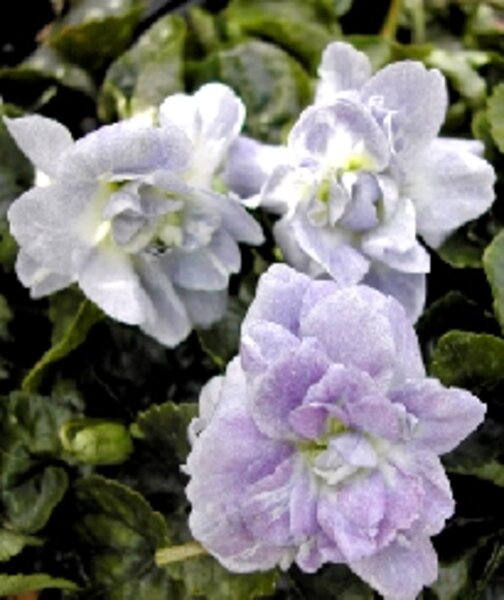The very fragrant Parma violet
Loading...
Parma violets are beautiful, relatively easy to grow, and, most of all, fragrant. Much favored about a hundred years ago, they fell out of fashion early in the 20th century when their winsome beauty was eclipsed by showier specimens. Now, with interest in heirloom plants on the rise, it is time for these elegant, beautiful violets to take center stage once more.
What makes a Parma violet different from other members of the viola family? Intense, “knock ’em dead” fragrance is the plant’s most prominent feature. In earlier times, when noxious odors were often unavoidable, the pervasive scent made Parmas especially popular for use in nosegays or small hand-held bouquets.
The leaves and flowers resemble those of many common backyard violets, except that the petals are usually doubled, making the individual blossoms look like small roses or pompons.
Like other violets, Parmas bloom in shades of purple, pinkish purple, or blue-purple. Some varieties also have white throats or contrasting petal edges. Conte di Brazza, often known as Swanley White, is the only Parma with pristine white blossoms.
Parma violets are also somewhat better mannered than other violet species. Since they rarely set seed, they are unlikely to become rampant when planted in outdoor beds.
The plants’ names – Duchess de Parme, D’Udine, Lady Elsington – are redolent of history and romance, as are the stories of the Parma’s origins.
Unlike other violet species, Parmas are unknown in the wild. Because they are not hardy in cold-weather climates, experts have speculated that they may have originated in warmer latitudes. Recent testing suggests that the Parmas might be descended from Viola alba, a species native to central Europe and the Mediterranean.
Wherever their journey began, the violets eventually migrated to Naples, Italy. They took a great leap forward in the late 19th century when a nobleman, Count Filippo di Brazza Savorgnan, began breeding them at his home near Udine in northeastern Italy. His efforts led to the Conte di Brazza violet, introduced in 1880 and still available today. The count, who was passionate about violets, also produced other popular hybrids.
Parma violets and their fragrant, single-flowered relative, Viola odorata, had their heyday from about 1870 through World War I. Many new varieties, often sports (or natural mutations) of older ones, appeared on the market.
Parma violet cut flowers became a commercial success as well. A New York Times article from 1892 refers to them as on sale in English florists’ shops. Another Times feature from 1905 describes an English society wedding where the attendants’ gowns were “the color of Parma violets,” evidently matching their bouquets, which were made up of the fragrant flowers.
In the United States, commercial violet culture centered on the Hudson River village of Rhinebeck, which, in the early 1900s, called itself the “Violet Capital of the World.” The Rhinebeck area was home to hundreds of violet producers, whose cut flowers were packed and sent by train to New York City vendors.
But after World War I, the wheel of fashion turned. In the 1920s, African violets replaced Parmas in parlors and flower shops, and the Depression put an end to large-scale greenhouse production of Parmas.
Away from the limelight, great old varieties such as the lavender-flowered Duchesse de Parme and the darker Marie Louise lived on in old gardens, the collections of violet fanciers and the fields and greenhouses of a few growers.
One of those growers is John Whittlesey of Canyon Creek Nursery in Oroville, Calif., who has sold the plants commercially for the past 25 years. According to Mr. Whittlesey, people still buy Parmas because of “family history” – relatives who grew or loved the plants – and “memories.” Demand, he says, has remained consistent throughout his career.
In climates without freezing winter temperatures, Parmas can be grown outside in sun to part shade in well-drained soil. Violet lovers in colder areas should set the plants outside after all danger of frost has passed and let them remain there until as late in the fall as possible, according to Mr. Whittlesey.
Once back indoors, the Parmas should be placed in a cool, sunny place, well away from heat sources.
Occasionally the violets may fall prey to red spider mites, which can be controlled by increasing the level of humidity around the plants and spraying them regularly with cold water.
Over the past decade, fragrance has made a comeback in the world of ornamental plants. Gardeners seek out older cultivars that are fragrant, and breeders are introducing new, fragrant varieties of everything from roses to coneflowers. Fragrant Parma violets may never make a comeback in florists’ shops, but they should be right at home in today’s gardens.
(Editor's Note: We invite you to visit the main page of the Monitor’s gardening site , where you can find many articles, essays, and blog posts on various garden topics.)





